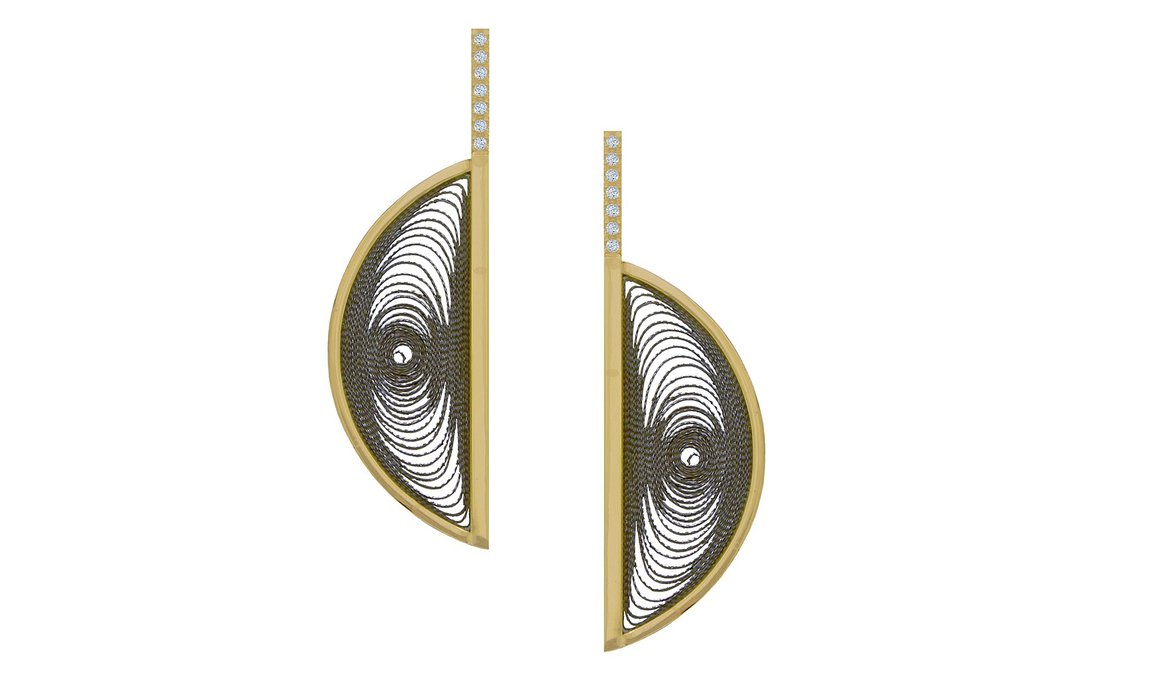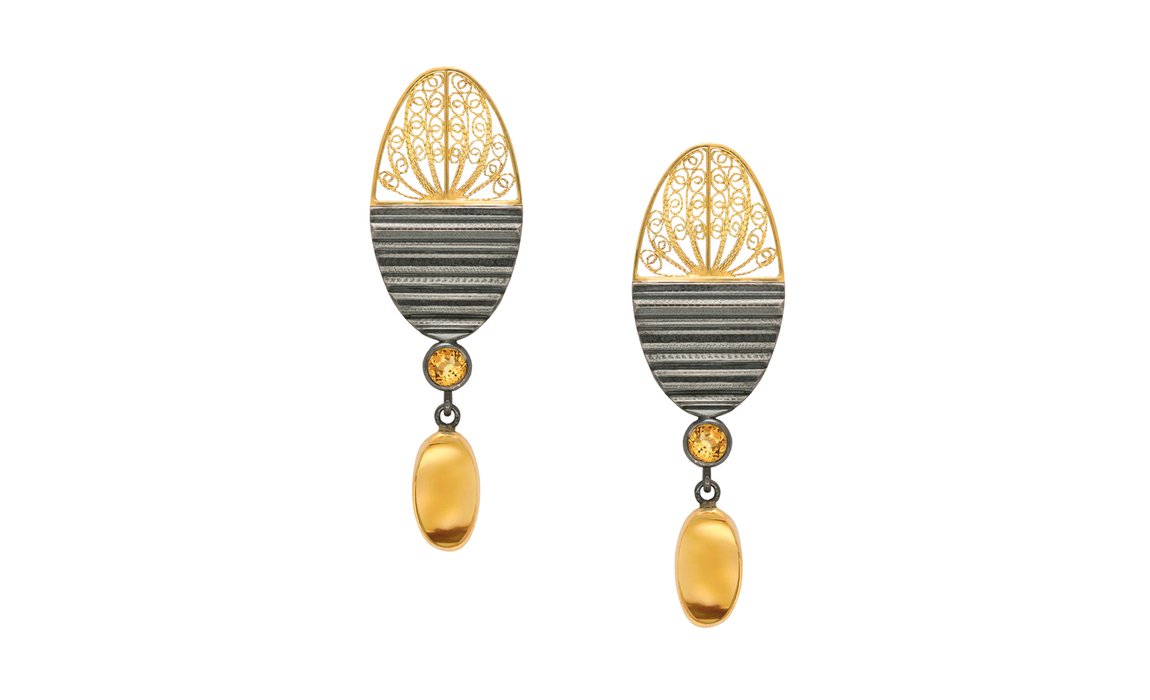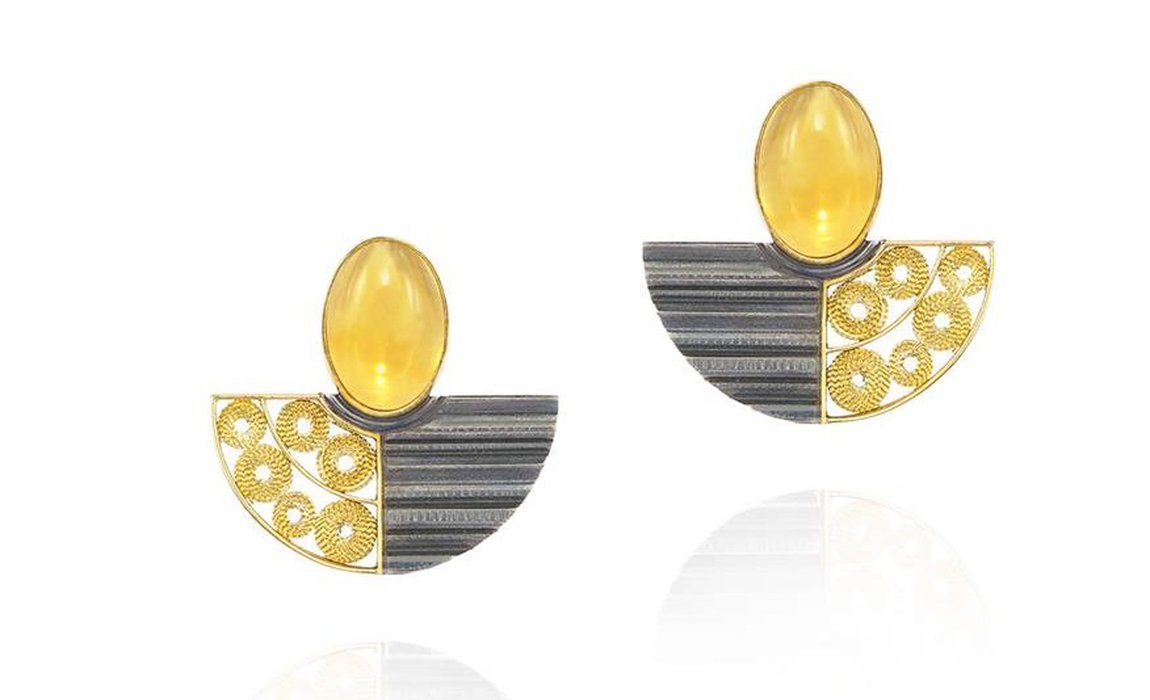Introducing Career Catalyst Grant 2020 Recipient Filipa Oliveira
Jeweller Filipa Oliveira’s fascination with the delicate technique of filigree started during her studies at CINDOR in Portugal. A technique rooted in Portuguese culture, she has dedicated her practice to filigree, transforming tiny silver and gold beads and twisted threads into artistic motifs and lace-like textures.
Not only is Filipa dedicated to passing on this ancient skill, but as one of the Goldsmiths’ Centre’s 2020 Career Catalyst Grant recipients she has been busy using her £5,000 grant to celebrate filigree in contemporary design and international culture.
Filipa joined us recently from her home studio in Portugal where she has spent her time during the pandemic to tell us how she is taking time out of her daily practice to develop a new Instagram account @contemporaryfiligree and a new book, dedicated to celebrating examples of filigree applied in contemporary jewellery design.
Introducing Career Catalyst Grant 2020 recipient Filipa Oliveira
Hello Filipa, thank you for joining us today. Can you tell us a little bit more about how you first became interested in filigree? What started your passion?
I first started to learn the technique of filigree in 2004, when I studied jewellery at CINDOR in Portugal, on a very technical course that lasted three years. During the first year, we learned a lot of different skills, like chasing, setting, silversmithing and repoussé, and that’s when I was introduced to filigree. I finished the course in 2007 and that same year, I realised that I wanted to learn more about the design side of jewellery, and so I continued my studies in Scotland, at Duncan Jordanstone College of Art and Design. There, when I was still in a more conceptual stage of my jewellery-making career, my passion for filigree was renewed.
Is filigree a very common subject at schools in Portugal, or is it quite unusual?
It’s a very traditional technique in Portugal. If you walk the streets and browse the craft markets or the jewellery shops, you'll see filigree on display. The course I did was very rich in terms of the techniques it covered, so of course it was included.
You are looking to develop online resources and a book to engage makers internationally with filigree. Why do you think that filigree is an important skill to share more widely?
Filigree is a really ancient technique. It has survived wars, conflicts and catastrophes for five thousand years. It has been passed from one generation to the other, from grandfathers to sons to grandsons, and it’s still here with us today. It has witnessed love stories, it has contributed to those love stories, and it has adorned queens and kings over the centuries.
For example, there is a gold filigree sheath, part of a gold dagger, that was found in the Royal Tombs of Ur in Iraq, which it’s now on display in the British Museum. There is also a toilet set that belonged to Catherine the Great made entirely of filigree. It’s important to celebrate our cultural heritage by contributing to this technique, and being a part of its ongoing history.


Where did the idea of a book on filigree come from, and are there any similar resources out there?
When I was studying jewellery in Scotland, we had to create a collection in our final year for our degree show. I decided to create contemporary filigree work because at the time, I felt the technique was disappearing as a result of a lack of innovation. As I said, you could see a lot of traditional filigree jewellery in shops in countries like Portugal, but it wasn’t jewellery that myself or my friends would wear.
Filigree has different motifs, there may be four or five traditional motifs that you can repeat using wire. But if you play with the wire, you can create something new, a modern motif, or you can add elements that you don’t see in traditional filigree - it could be a stone, a found object, enamel, or patination.
I felt that innovation was necessary, and I started researching to look for inspiration, but I discovered I couldn’t find any books at the university library, or by searching online. It was difficult to find a book on traditional filigree and there was nothing at all on contemporary filigree. I couldn’t even find anything on online platforms like Instagram or Facebook. I was a student, trying to find that information, so I knew that there must be other students in other countries, perhaps even in the UK, searching for the same resources and being unable to find anything. Since then, I’ve been interested in creating this project - I’ve been waiting for this moment.
Why do you think it will make an impact on the craft?
I think a book will make an impact because it will show where the technique is today, and how it contributes to contemporary culture. I think it will inspire both students and other makers to explore and use filigree more. In the industry, and even within the general public, I think there’s an increased interest in this technique.
How would you describe the book - is it a how-to guide, or is it more for inspiration and context on the technique?
The book shows the contemporary side of filigree, with images, concepts, and profiles of international makers. Maybe in the future, I will consider creating another book and online resource that is focused on how to learn the technique, but for the moment, I’m doing that through filigree short courses, including at the Goldsmiths’ Centre.
It’s a complex technique, so learning from books is a bit limited, and it’s best to experience it for the first time in a physical workshop. The wire is not available from any domestic supplier, so both the wire and the wire-engineered tools must be made yourself, and it’s very detailed and methodical work. In my workshops and courses, I teach you how to make the wire and the tools, and how to master heat when soldering, as in filigree, you must be very careful with the heat. I think learning from books is difficult and limited for this technique.

So what chapter or part of the book are you most excited about?
The part that I'm most excited about is focused on contemporary filigree work and the concept and inspiration behind the work. There’s so many fascinating pieces that when you look at them, you wonder where the idea could have come from, so it’s really interesting to have the makers explain that. I think that’s really exciting, and that people will be surprised to learn how the technique is spreading all over the world - from America, to Australia, Chile, Germany, Cyprus, Israel, Colombia, Turkey, Portugal and Italy, and so on.
What have you learned from the process so far?
I’ve learned that I'm not alone, that there are other makers out there who feel exactly the same as me about filigree. On their websites I read their motivations, the same as mine...the technique is disappearing because of lack of innovation, fewer and fewer makers are using it, and that we need to show that it isn’t dying, that it is being modernised, and that we are teaching it to others. Building a community is necessary and it’s an important tool for sharing contemporary filigree with the world.
Does the Career Catalyst Grant give you the freedom to experiment in a way you might otherwise be unable to?
It has, most of all I think it has given me time. This project takes up a lot of research. There isn’t any platform that holds the work of all the different makers using contemporary filigree, so I have to go and find these makers. If it wasn't for the Career Catalyst Grant, I couldn't take all this time out of my work to dedicate myself to this project, so I think it has been really important.
I’ve also developed new skills through creating the book. I had no idea how to write a synopsis when I started out; what it needed to incorporate. So, by building the book myself, I’ve learned about all these new elements. In terms of digital skills, I was already familiar with Facebook and Instagram and had created a website before, so it wasn’t completely new, but there’s always more to learn.


What publishing options are you currently exploring?
I was initially thinking about self-publishing, but with the pandemic, I think it will be harder to get the book in the shops, as publishers will already have those contacts in place for distribution, whereas I will have to build them myself, which will be difficult in the current climate. I think finding a publisher is the best option, though it will take a little time. All of us are finding that the projects are taking more time than expected because of what we’re living through at the moment. We’re all learning to be more patient.
What unexpected things have happened during this project, and how have you reacted or adapted to try and manage that?
I contracted Covid during the project, but it was fine - myself and some family members had only mild symptoms. Like I said, I think the main thing is that the project is going to take more time than expected. I hope that maybe it will inspire some travelling, in the sense that people will build their interest on the technique, and it will lead to them visiting museums or doing workshops abroad. Teaching is so important, as the more you teach the technique, the more it can be modernised, because each maker can apply their own personal approach.
What's next for you?
A perfect idea for the future would be travelling to teach the technique in different countries, meet filigree makers, see museums dedicated to the technique, create new work, inspiring people through the blogs and the book, and using it to create a community and share what others are making.
It’s not confirmed at the moment, but a launch event for the book along with an exhibition with pieces from each maker on display that people could see in person could also be part of the project.
If you incorporate filigree in your work, Filipa would love to hear from you and share your work. You can send her a direct message via her Instagram account @contemporaryfiligree or email contemporaryfiligree@gmai.com